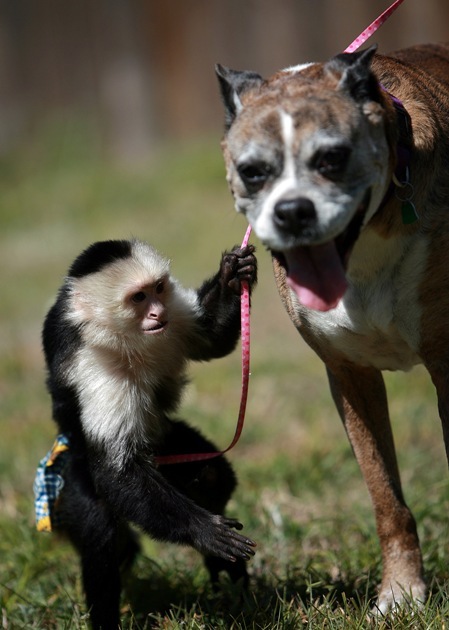Monkeys implanted with brain electrodes were able to see and move a virtual object and sense the texture of what they saw, a step forward in the quest to help the severely paralysed touch the outside world once more.

"Someday in the near future, quadriplegic patients will take advantage of this technology," said lead investigator Miguel Nicolelis, a professor of neurobiology at Duke University in North Carolina.
They will seek "not only to move their arms and hands and to walk again, but also to sense the texture of objects placed in their hands, or experience the nuances of the terrain on which they stroll with the help of a wearable robotic exoskeleton."
Publishing their work on Wednesday in the British journal Nature, Nicolelis's team implanted multiple electrodes in both brain hemispheres in two rhesus monkeys.
Using brain power, the monkeys manipulated a virtual paw to reach up to three identical objects displayed on a computer screen.
Touching one of the objects that had a specific tactile feedback -- in essence, getting a sensation of its "surface" -- gave the monkeys a reward of fruit juice.
Holding the virtual paw over the wrong object cancelled the trial.
It took one monkey only four attempts, and the other nine attempts, before they figured out how to select the right object.
Scans of brain activity showed that they were actually sensing the object and not selecting it randomly.
The work adds an important dimension to the search, still confined to laboratories, to restore control over objects to paralysed individuals by connecting their brain to computers and control machinery.
Instead of a "brain-machine" interface, the possibility now is of a "brain-machine-brain" interface, or BMBI, say the scientists.
In the case of the monkeys, a population of 50-200 cells in the primary motor cortex controlled the avatar arm.
At the same time, the monkeys were getting electrical feedback of the texture of the object through the implants in the primary somatosensory cortex.
It is this simultaneous move-and-touch that is the breakthrough, said Nicolelis.
"Such an interaction between the brain and a virtual avatar was totally independent of the animal's real body, because the animals did not move their real arms and hands, nor did they use their real skin to touch the objects and identify their texture.
"It's almost like creating a new sensory channel through which the brain can resume processing information that cannot reach it anymore through the real body and peripheral nerves."
The fact that this was achieved with non-human primates makes it doubly exciting.
In the not-too-distant future, Nicolelis hoped, it may be possible to create a robotic external skeleton that not only restores movement by direct control of the brain but also gives sensation of surfaces.
An international scientific team called the Walk Again Project has proposed carrying out a demonstration of a BMBI exoskeleton at the opening match of football's 2014 World Cup in Brazil, Duke University said in a press release.
<한글기사>
원숭이, 뇌파로 버추얼 물체 느끼고 움직여
사지마비 환자 재활에 획기적 진전
훈련받은 원숭이들이 컴퓨터 화면 속 가상의 물체를 뇌파만으 로 느끼고 움직일 수 있는 것으로 밝혀져 사지마비 환자의 운동과 감각 능력을 되살 리는 기술이 눈 앞에 다가왔다고 사이언스 데일리가 6일(미 동부시간) 보도했다.
미국 듀크대학 연구진은 5일자 네이처지에 실린 연구에서 "가까운 장래에 사지 마비 환자들이 이 기술을 이용해 손과 팔을 움직이고 다시 걸을 수 있게 될 것이다.
그 뿐만 아니라 손에 쥔 물체의 감촉을 느끼고 로봇장치의 도움으로 딛고 있는 땅의 미묘한 느낌까지 경험할 수 있게 될 것"이라고 말했다.
원숭이들은 실제 신체 부위를 전혀 움직이지 않고 뇌파만으로 화면 속의 가상 팔을 움직여 버추얼 물체 표면에 갖다 대고 접촉한 뒤에는 촉감의 차이를 구별할 수 있었다.
연구진은 원숭이들이 원래 제 팔을 사용하는 것처럼 팔 제어 신호를 보내면서 물체의 촉감을 이해하는 전기적 피드백을 얻는 두 가지 동작을 동시에 할 수 있었다 고 밝혔다. 원숭이들은 버추얼 물체의 촉감을 뇌로 전달되는 미묘한 전기신호의 패 턴으로 표현했다.
실험에 사용된 버추얼 물체들은 겉보기엔 같아도 각기 다른 인공적인 촉감을 갖 도록 설계됐고 이런 촉감의 차이는 원숭이들이 뇌파로 직접 버추얼 손을 조작해야만 느낄 수 있도록 만들어졌다.
원숭이들은 처음엔 조이스틱을 사용해 화면 속의 물체를 조작할 때마다 먹이를 상으로 받았고 다음엔 조이스틱을 치우고 뇌파 만으로 조이스틱을 조작해 버추얼 팔 을 움직이도록 훈련받았다.
연구진은 `뇌-기계-뇌 접속' (BMBI)의 과정에서 실제 신체부위는 전혀 사용되지 않았다면서 "이 실험은 뇌와 버추얼 신체 사이의 직접적인 양방향 관계를 구축한 최 초의 BMBI 사례가 될 것"이라고 말했다.
이들은 "사람이 아닌 영장류가 거둔 이처럼 큰 성공 덕분에 우리는 장차 사람도 가까운 장래에 이와 똑같은 일을 해낼 수 있을 것이라고 믿게 됐다"고 밝혔다.
원숭이 중 한 마리는 4번의 시도 끝에, 다른 한 마리는 9번의 시도 끝에 정확한 물체를 골라내는 법을 배웠으며 몇 번의 시험 결과 이들은 실제로 물체의 촉감을 느 끼는 것으로 나타났다.
연구진은 이 실험을 토대로 장차 사지마비 환자가 사용할 수 있는 로봇 외골격 장치를 만들 수 있을 것이며 환자는 보다 독립적인 운동이 가능하게 될 것이라고 말 했다.
사지마비 환자의 완전 재활을 목표로 브라질과 미국, 스위스, 독일 과학자들이 설립한 비영리 콘서시엄 `워크 어게인 프로젝트'(Walk Again Project)의 과제인 이 연구는 미 국립보건연구소(NIH)의 지원으로 이루어졌다.
WAP 과학자들은 오는 2014년 브라질에서 열리는 월드컵 대회의 오프닝 경기에서 이 장치를 시연하자고 제안했다
.







![[KH Explains] How should Korea adjust its trade defenses against Chinese EVs?](http://res.heraldm.com/phpwas/restmb_idxmake.php?idx=644&simg=/content/image/2024/04/15/20240415050562_0.jpg&u=20240415144419)











![[Today’s K-pop] Stray Kids to return soon: report](http://res.heraldm.com/phpwas/restmb_idxmake.php?idx=642&simg=/content/image/2024/04/16/20240416050713_0.jpg&u=)